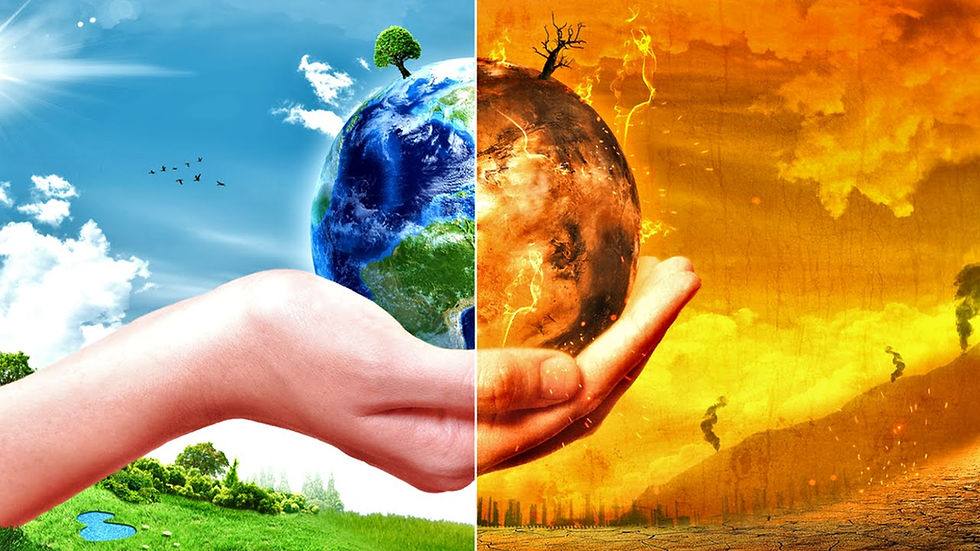Climate Change
- Jacob Garland

- Dec 31, 2017
- 4 min read
Updated: Mar 18, 2018

As this is only the second post of this blog, I find it best to start with a determined theme for my posts. While almost all of us have a general idea on what climate change, deforestation, industrialization, and the like are, not many know of the specifics and the true scale of these problems. As such, I plan to go through each individual problem and explain them. Once we know what these problems are, we can begin to discuss and stop them. This is the beginning of a series of posts I hope to write, entitled “The Problem.” These posts won’t come right after another, but rather I plan to alternate between posts about various problems and posts about possible solutions.

The first problem on the list is climate change. Many people like to think of climate change by another name, global warming. However, this doesn’t describe what is truly happening to our planet. While it is true that parts of the Earth are heating up due the excess amount of Co2 in our atmosphere, climate change can even make things colder. Generally, the climate change that we are experiencing results in climate extremes, whether they be cool or hot. One of the largest arguments I hear from fellow classmates and friends around me regarding climate change is, “We’ve just had one of the coolest and snowiest winters two years ago (in the New England area)!” If anything, this further proves that climate change is happening quickly. As stated earlier, climate change results in extreme weather, i.e. really cold or warm winters and summers. The normal climate of winter and summer can begin to shift, as we have clearly seen in the past two years. Two years ago, we had record breaking snowfalls and extremely cold temperatures. Yet, last year, snowfall, at least in the Massachusetts area, was nearly nonexistent, and the winter was warm throughout. This quick shift in norms is a clear sign that climate change is happening much faster than we think.

So how exactly does climate change occur? Well, firstly, it's important to say that climate change is normally a natural occurrence. It is normal to see slight changes in climate over the course of many years; scientists have seen it before on Earth. However, it starts to become unnatural when this change happens to quickly, when the hots and colds change too fast. When this happens, many problems start to occur. But why is the change suddenly accelerating?

It all has to do with greenhouse gasses, as I’m sure most have heard of. Like a slow climate change, greenhouse gasses are usually completely natural, and they are the reason that our temperature on Earth is regulated (https://www.epa.gov/ghgemissions). A few examples of greenhouse gasses are water vapor, carbon dioxide, and methane. All of these trap heat from the sun, and help to make sure our Earth doesn’t become too cool. However, with the recent industrialization of the past century, humans have begun to release their own greenhouse gasses through the burning of fossils fuels. This releases carbon dioxide, which gets trapped in the atmosphere and in turn traps more heat. It’s estimated that every year, 281 gigatonnes of land ice melt every year due to climate change. The sea level also rises 3.5 millimeters per year because of the melting ice. (http://climate.nasa.gov/). While this change in sea level doesn’t seem like much, if it continues to rise it can easily begin to flood coastal areas like Florida in the next decade or so (https://www3.epa.gov/climatechange/impacts/coasts.html).

Climate change this fast can create unsuitable environments for plants that live within them. If the Earth continues to heat and cool so drastically, many plants won’t be able to survive. They’ll die off, and we’ll only be left with the hardiest plants that provide little resources to animals. Because of this, many herbivores will also die off, leaving many species extinct.
These aren’t even all of the repercussions we need to worry about. Climate Change affects humans too. By 2065, the average annual temperature in North America, Europe, and East Asia are estimated to increase by 2-4 degrees Celsius (35.6-39.2 degrees Fahrenheit!) (http://why-sci.com/climate-change/). Not only will this change how humans live, but it can even affect how much violence there is in the world. If there is a 2 degree Celsius increase in temperature, it is estimated that violence around the world can increase by up to 50%. The change in climates can also result in warmer areas up North, meaning Mosquitoes can affect many more people, leading to hundreds of thousand more deaths per year because of diseases like Malaria and Triple E.

These problems will only continue to increase over the coming years. Changing our ways is the only chance we have of saving the environment, ourselves, and the planet. While it seems like there is nothing we can do to save it, simple changes to our lifestyles, if adopted worldwide, can make a huge difference. We can still save our planet, if all of us are willing to put in the time.
Now you may be wondering, “What can I do to help?” There are many answers to this question, too many for this post. Look to my next post coming next week to see what you can do to decrease the production of harmful Co2 in our atmosphere. If you like what you’ve seen, make sure to follow my blog as I plan to write more posts in similar fashion. Thanks for reading.
All credit for information used in this post goes to:
https://www.epa.gov/ghgemissions
http://climate.nasa.gov/
https://www3.epa.gov/climatechange/impacts/coasts.html
Images:
https://www.youtube.com/watch?v=ifrHogDujXw
http://www.takepart.com/flashcards/what-is-climate-change
http://eskipaper.com/snowfall-1.html#gal_post_84171_snowfall-1.jpg
https://prezi.com/xxbdfluxtujf/the-effects-of-food-waste-on-the-environment/
https://www.pinterest.com/pin/444026844493784691/
http://www.bbc.com/news/health-35427491




Comments